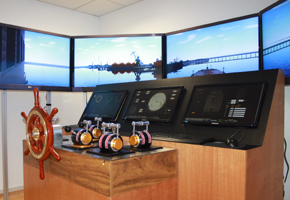

Equipment allows researchers to forecast risky berthing maneuvers and simulate ship commands after construction work at ports
Equipment allows researchers to forecast risky berthing maneuvers and simulate ship commands after construction work at ports.
Equipment allows researchers to forecast risky berthing maneuvers and simulate ship commands after construction work at ports.

Equipment allows researchers to forecast risky berthing maneuvers and simulate ship commands after construction work at ports
By Karina Toledo
Agência FAPESP – The Numerical Testing Tank (TPN), a laboratory linked to Universidade de São Paulo’s Polytechnic School (Poli-USP), recently inaugurated the Maritime Waterway Simulator (SMH), which is used to reproduce the sailing and berthing conditions of ships in narrow waterways, such as canals, ports, and rivers.
Developed by a team coordinated by Professor Eduardo Aoun Tannuri, in partnership with Transpetro, a Petrobras subsidiary, the system allows users to precisely forecast risky berthing maneuvers and simulate the command conditions for ships after construction work at ports.
SMH is housed in two rooms of Poli-USP’s laboratory. In one room, there are between 10 and 12 screens, some as large as 46 inches, to simulate the view from the control room. Below the large screens are smaller screens that imitate such instruments as radars, GPS, electronic navigation charts, and speed and inclination controls. The laboratory also has a helm and controls.
The second room contains just one screen, 6 m wide and 2 m high, in addition to a replica of a bridge that includes a chair that moves to simulate the swaying of a ship.
All screens are connected to a computer that simulates wind, waves, currents, tides, and visibility conditions such as fog, night, rain, and sun using a mathematical model developed at TPN.
“The SMH is the only simulation hardware and software developed entirely in Brazil. It is the fruit of more than 20 years of research at the laboratory and utilizes the same mathematical model used in the engineering and projection of ships. For this reason, it is highly refined, with validations based on published experiments,” affirms Tannuri.
The equipment can be configured for different types of ships, from the most modern to the oldest models, said the researcher. “We just bought 12 more screens to assemble a version with 360º visibility,” he explains.
According to Tannuri, the demand for this type of service has grown in Brazil due to governmental investment in expanding and modernizing its port system. To date, the SMH has been used to simulate maneuvers at the ports of Suape (PE), Pecém (CE), Itaqui (MA), Tubarão (ES), Angra dos Reis (RJ), Rio Grande (RS), and some other port terminals in Rio de Janeiro and Santos (SP).
“In the Port of Tubarão, for example, we simulated berthing for the largest ship in the world, the Vale Brasil, before it actually happened. Such simulations help to prevent accidents and setbacks,” explains Tannuri.
Fluvial maneuvers
The simulator was originally intended to aid ships on the Tietê-Paraná waterway, also in partnership with Transpetro, explains Tannuri. The objective was to train operators of river barge convoys that transport alcohol and biodiesel.
This first version was launched in 2010 and, in the following year, the group launched the Offshore Virtual Simulator, created to train oil rig operators who conduct oil transfer operations at offshore platforms.
“Today, there are two versions of the offshore simulator: one at the Transpetro Academy and the other in the Marine’s Ciaga [Almirante Graça Aranha Training School]. Both are located in Rio de Janeiro City,” comments Tannuri.
The SMH was launched in the second half of 2012. At present, the team, again in partnership with Petrobras, is working on a new research project that envisages the construction of five integrated simulators.
“This will allow for multiplayer simulation, or, rather, one person simulating navigation and interacting with another in, for example, a tugboat,” explains Tannuri.
In addition to meeting Petrobras’ demand and rendering services to several other companies, the simulator had been a work tool for several researchers that have come through TPN in the last 20 years, including Tannuri himself.
“My doctorate and post-doctorate research, conducted using FAPESP fellowships, were focused on developing the mathematical propulsion and positioning models implemented in the simulator,” he explained.
Thus far, the researcher has developed software to simultaneously control the positioning of two ships in the open sea, which will allow for complex operations, such as the transfer of oil from one ship to another. This project was also funded by FAPESP.
The control algorithms of the wave tank, which is 14 m by 14 m with a depth of 4 m, that are used to make small-scale simulations and validate measurements conducted by the mathematical model were developed during the doctoral studies of Mario Luis Carneiro, under Tannuri’s guidance and through a FAPESP fellowship.
For Tannuri, in addition to the products generated, the projects developed at TPN are important because they help to train human resources in the area.
“Many engineers have come from this program and are at Petrobras or other engineering companies. Buying a ready-made simulator without knowing how it works is entirely different. Developing a product like this allows students and researchers to train throughout the process,” he affirms.
Republish
The Agency FAPESP licenses news via Creative Commons (CC-BY-NC-ND) so that they can be republished free of charge and in a simple way by other digital or printed vehicles. Agência FAPESP must be credited as the source of the content being republished and the name of the reporter (if any) must be attributed. Using the HMTL button below allows compliance with these rules, detailed in Digital Republishing Policy FAPESP.





